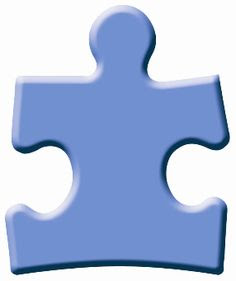A study finds that the puzzle-piece representation of autism creates associations that are overwhelmingly negative: “imperfection, incompletion, uncertainty, difficulty, the state of being unsolved, and, most poignantly, being missing” — all of which are regularly exploited by “Autism Speaks” propoganda.
The study asks, Is it time to ditch the puzzle piece as a symbol of autism?
In the authors’ words: “If an organization’s intention for using puzzle-piece imagery is to evoke negative associations, our results suggest the organization’s use of puzzle-piece imagery is apt. However, if the organization’s intention is to evoke positive associations, our results suggest that puzzle-piece imagery should probably be avoided.”
Speaking for myself, the single blue puzzle piece DOES hold negative connotations. I find it synonymous not with autism but with Autism Speaks and the pathologizing and demeaning way with which it frames my condition.
While no one image will please everyone, I want to point, instead, toward autism symbology that has positive connotations for me. The awareness ribbon consists of interlocking puzzle pieces of MANY colors, not just blue. For me, it symbolizes that every one of us is unique, but we face challenges and barriers posed by a society not built for us. We gain strength through our shared experiences.
Here’s a description by the Autism Society, which holds the image trademark, but has granted use to other agencies:
“The puzzle pattern reflects the complexity of the autism spectrum. The different colors and shapes represent the diversity of the people and families living with the condition. The brightness of the ribbon signals hope — hope that through increased awareness of autism, and through early intervention and access to appropriate services/supports, people with autism will lead full lives able to interact with the world on their own terms.”
Subscribe to:
Post Comments (Atom)
Subject Classifications (Partial list, via Dewey Decimal System)
- 006.754-Social Media
- 020-Library and Information Science
- 020.7025-Library Education
- 020.92-Cynthia M. Parkhill (Biographical)
- 023.3-Library Workers
- 025.00285-Digital libraries
- 025.04-Internet Access
- 025.2-Libraries--Collection Development
- 025.213-Libraries--Censorship
- 025.3-Libraries--Cataloging
- 025.84-Books--Conservation and restoration
- 027.473-Public Libraries--Sonoma County CA
- 027.663-Libraries and people with disabilities
- 027.7-Academic Libraries--University of Central Missouri
- 027.8-School Libraries--Santa Rosa Charter School for the Arts
- 028.52-Children's Literature
- 028.535-Young Adult Literature
- 028.7-Information Literacy
- 158.2-Social Intelligence
- 302.34-Bullying
- 305.9085-Autism (People with Developmental Disabilities)
- 306.76-Sexual orientation and gender identity
- 371-Schools--Santa Rosa Charter School for the Arts
- 371-Schools--Santa Rosa City Schools
- 636.8-Cats
- 646.2-Sewing
- 658.812-Customer Service
- 659.2-Public Relations
- 686.22-Graphic Design
- 700-The Arts
- 746.43-Yarn bombing (Knitting and Crochet)
- 808.51-Public Speaking
- 809-Book Reviews

No comments:
Post a Comment
Robust debate and even unusual opinions are encouraged, but please stay on-topic and be respectful. Comments are subject to review for personal attacks or insults, discriminatory statements, hyperlinks not directly related to the discussion and commercial spam.